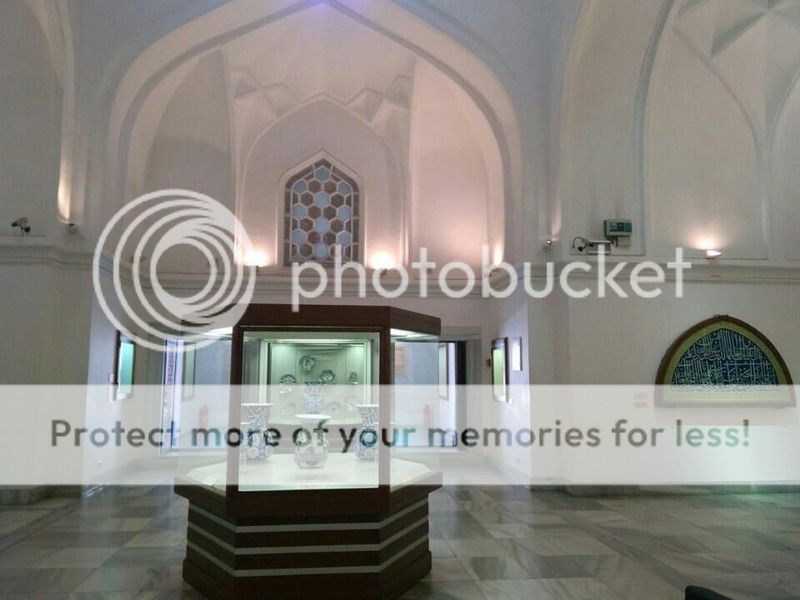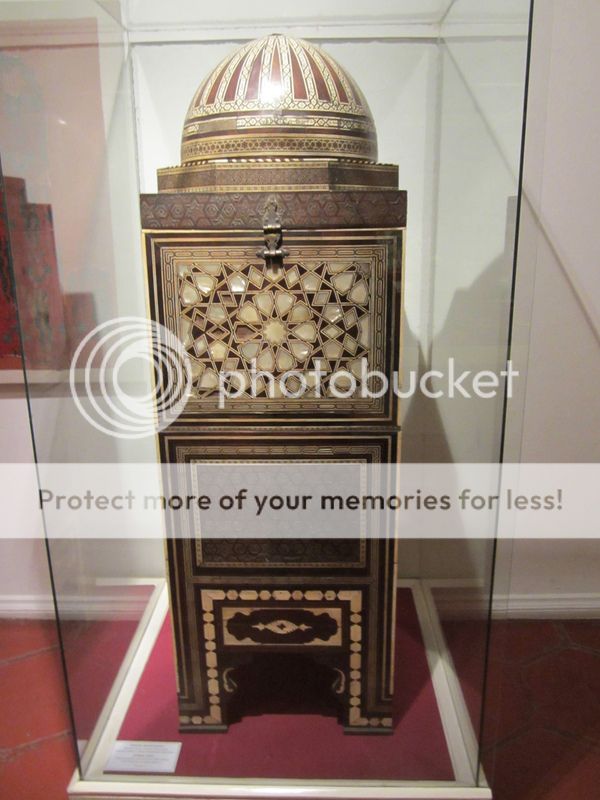GPS : 41°00'43.0"N 28°58'52.5"E / 41.011941, 28.981260

PHOTOGRAPHS ALBUM
It was used as the Imperial Museum between 1875 and 1891 before the collection moved to the newly constructed main building. It was opened to public in 1953 as a museum of Turkish and Islamic Art, and was later incorporated into the Istanbul Archaeology Museum.
The Tiled Kiosk was commissioned by Sultan Mehmed II in 1472. It is one of the oldest structures in Istanbul featuring Ottoman civil architecture and was a part of the Topkapı Palace outer gardens. This summer pavilion dating back to 1472 is an example of early Ottoman architecture influenced by the Seljuks, with a facade in which colorful movement is achieved by columns, a balcony with an antechamber, and cut tile decorations. There is a long inscription on the wall beside the door.
The entrance façade of the kiosk is single-flat and the back façade is of two-storeyed. There is a marble porch of 14 columns in the entrance. The entrance exedra is decorated with mosaic enamels. Various chinaware and ceramics from the Seljuk and Ottoman period are displayed in the Kiosk that consists of 6 rooms and a middle saloon.
This is the striking two-storied, building opposite the Archeological Museum. It is actually the first pavilion of the Topkapı Palace and was built by Mehmet the Conqueror. The domed entrance section is flanked with vaulted rooms. Here 13th - 19th century Seljuk and Ottoman ceramics and tiles are exhibited in chronological order. 16th century tiles from Iznik constitute one of the most important collections of the museum.
The collections of the Tiled Kiosk Museum consist of about 2000 artifacts belonging to the Seljuk and Ottoman eras, dating from the 11th-20th centuries. These artifacts include those that existed when the museum was incorporated into the İstanbul Archaeological Museums due to its closeness and those acquired through excavations, purchases, donations and confiscations.
In the Tiled Kiosk Museum, tiles and pottery chosen from these collections are exhibited: There are artifacts from the Seljuk era in the room left to the entrance, slip casted artifacts from Miletus in the iwan on the left that is opening to outside, artifacts made in İznik in the middle gallery and in the room with five corners, artifacts made in Kütahya in the room at the right corner facing the Gülhane Park, and artifacts made in Çanakkale in the right iwan opening to outside.
COLLECTIONS
The collection includes notable examples of Islamic calligraphy, tiles, and rugs as well as ethnographic displays on various cultures in Turkey, particularly nomad groups. These displays recreate rooms or dwellings from different time periods and regions. Rare works of art created in various Islamic lands are on display in the hallways and the rooms. The stone, baked clay and metal objects, ceramic wares and handwritten books are some of the most valuable examples of their period.
Carpets
The carpet section forming the richest collection of carpet art in the world had a separate importance and caused the museum's being famous as a "Carpet Museum" for long years. The museum has the richest carpet collection of not only Turkey, but also the world. Besides rare Seljuk carpets, prayer rugs and animal figured carpets belonging to the 15th centuries and the carpets produced in Anatolia between the 15th - 17th centuries and called as "Holbein Carpet" in the West inspired by the geometrically figures or kufi writing are the most valuable parts of this section.
Turkish and Islamic Works Museum carpet collection that became richer with Iranian and Caucasian carpets and famous Uşak and palace carpet samples is a reference, which the ones carrying out a serious research on the carpet art in the world must apply to.
The carpets exhibited in the section fitted with glass panes near the large chambers are magnificent examples of 13th-20th century handmade Turkish carpets. This matchless collection is the richest of its kind in the world. 13th century Seljuk carpets and other examples from subsequent centuries are exhibited with much care. The floor below the carpet section is the ethnographic collection where one can get a glimpse of everyday Turkish life and objects in daily household use in the past.
Hand Writings and Calligraphy
Koran-i Kerims constituting a big part of the writing collection of Turkish and Islamic Works Museum from the 7th century to the 20th century come from a large geographical region where Islam has spread over. It is one of the rare collections, where Emevi, Abbasi, Egypt and Syria Tulunoğulları, Fatımi, Eyyubi, Memluk, Moğol, Türkmen, Seljuk, Timuri, Safavi, Kaçar and Anatolian Principalities and Ottoman calligraphy creations can be observed all together.
Among the hand writings, except Korans, there are books (some of them with pictures) written about various subjects and these draw attention both in terms of their writing styles and their coatings. Imperial edicts, warrants bearing the signatures of Ottoman sultans, the sultan's signatures each of which is a work of art, Turkish and Iranian miniature writings make Turkish and Islamic Works Museum one of the most important museums of the world.
Wooden Works
The most important parts of this collection are the samples of Anatolian Wood art of the 9th - 10th century. Besides the unique parts that remained from the Anatolian Seljuks and principalities, mother - of - pearl, ivory, tortoiseshell ornamented wooden works of the Ottoman Period, unique samples of inlaying art, Koran part cases, bookrests, drawers are the interesting parts of this rich collection.
Stone Arts
Stone works belonging to Emevi, Abbasi, Memluk, Seljuk, Ottoman periods, some of which have motifs and some of which have figures, but all of which have writings have been gathered in Turkish and Islamic Works Museum. Unique and elite samples of stone art of Seljuk Period, grave stones on which hunting scenes, fairy creatures such as sphinx, griphon, dragon, early - period stone works with kufi writings, inscriptions written in different methods that are projections of Ottoman calligraphy art are important both in quality and in quantity.
Ceramic and Glass
In this collection consisting mostly of the ceramic works found in the excavations made between 1908 - 14, the ones from Samarra, Rakka, Tel Halep, Keşan are in the first ranks. It is possible to see the stages of Early - Islamic Period ceramic art in the collection of Turkish and Islamic Works Museum. The mosaic, mihrab and wall encaustic tile samples belonging to the Anatolian Principalities and Seljuk Periods and the plaster ornaments of Konya Kılıçaslan Palace constitute another important part of the collection. Ottoman encaustic tile and ceramic art samples end with near - period Kütahya and Çanakkale ceramics. The glass collection starts with the 9th century Islamic glass art samples and includes the 15th century Memluk candles, Ottoman period glass art samples.
Metal Arts
Turkish and Islamic Works Museum Metal Art Collection starting with the unique samples belonging to the Great Seljuk Empire period and mortar, censer, long - spouted ewer, mirror and dirhems constitute an important collection with the door knockers of Cizre Ulu Mosque and the 14th century candelabrums ornamented with constellation and planet symbols, which have an important place in Islamic metal art. Among the Ottoman metal art samples starting from the 16th century and reaching the 19th century, there are silver, brass, tombac (ornamented with valuable stones) crests, candles, rose water cans, censers, washtub / ewer sets.
Ethnographic Department
Ethnographic parts collected for long years have found the possibility of being exhibited with the transfer of Turkish and Islamic Works Museum to Ibrahim Pasha Palace. The youngest part of the museum is exhibited in this collection, consisting of carpet - kilim looms collected from various regions of Anatolia, wool painting techniques, public weaaving and ornamenting art samples, clothes in their regional enhancements, house goods, hand arts, hand art instruments, nomad tents exhibited in places special to them.
LOCATION SATELLITE MAP
WEB SITE : Istanbul Archaeological Museums Administration
MORE INFO & CONTACT
Tel : +90 212 520 7740
Fax : +90 212 527 4300
E-Mail : info@istanbularkeoloji.gov.tr
These scripts and photographs are registered under © Copyright 2017, respected writers and photographers from the internet. All Rights Reserved.
